Wondering if publishing organic social is worth your time? Looking for tips to improve your organic social content?
To explore the power of organic content marketing, I interview Larry Kim on the Social Media Marketing Podcast.
Larry Kim is the founder of WordStream and Mobile Monkey. He’s a content marketing pro and a top writer in entrepreneurship on Medium.
Larry shares tips for using organic content on LinkedIn, Facebook, and Twitter. You’ll also discover how to get exposure via organic content on Medium.
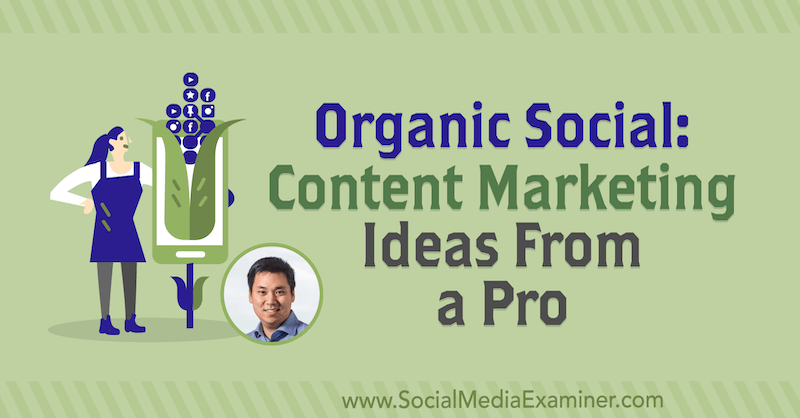
Is Organic Social Media Dead?
We live in an age where everybody’s focused on paid acquisition, yet Larry seems to have successfully used organic pretty dramatically. He believes that getting organic reach is harder than it used to be but it’s certainly still possible.
Larry figures that mathematically, roughly one out of every five posts on the Facebook or Twitter feed is an ad—which means four to five of those posts are organic. Someone’s getting those impressions and that engagement—and if it’s not you, it’s going to be somebody else.
It used to be a bit easier to get a little slice of the organic social media action. There were participation points: Everyone was a winner as long as they did something. Larry feels that the algorithms today are slightly more lopsided. They tend to have favorites, more like “winner take all.” Like playing Powerball as opposed to a scratch ticket.
Larry’s Twitter account typically receives around 20–30 million impressions a month with no paid advertising. His Medium account gets about 2 million views per month. His LinkedIn page gets around 10,000 profile views and it’s regularly possible for him to get up to several hundred thousand views on his content. This is all organic. But Larry is definitely employing different strategies from what he was doing just a few years ago, and those strategies are platform-specific.
Why Should People Publish Organic Social Content?
The benefits of posting organic social content are enormous. Larry says that with something like LinkedIn or Medium, all sorts of crazy opportunities come—fundraising opportunities, high-powered interviews—things just appear in the LinkedIn inbox. All sorts of incredible opportunities can flow from it but for those inquiries to find their way to your inbox, you have to put yourself out there.
It’s hard to exactly quantify the ROI of organic social content because it’s very random. It’s not direct response marketing; you’re not driving installs of your product. People see something, then a journalist calls, someone invites you to a conference, and so forth. It’s more about indirect benefits ranging from job opportunities to speaking opportunities to media inquiries to business opportunities and partnerships.
The way this works varies based on the platform. Twitter can be especially effective for increasing reach and gaining opportunities. Larry has about 800,000 followers, and during this coronavirus pandemic, he’s been following updates from different politicians and CDC experts. He’s finding to his great surprise that many of them have actually followed him back.
The reach is there if you’re able to understand how these algorithms work, crack them, and really take advantage of them. Is it worth your time to do that?
If you’re going to do it, you have to be in it to win it. You need a well–thought-out strategy. It doesn’t have to be for all of the different platforms. You can pick one that’s really good for your niche. Just go all in and do what it takes to be a winner there now. So many people try things that don’t work and then blame the platform for their failure. You need to test and try a lot of different things, then double down on what works best.
Organic Content on LinkedIn
Larry finds LinkedIn to be the easiest platform for organic reach. If you have a very modest following, LinkedIn’s algorithm gives you the highest potential to get millions of views. Larry has some LinkedIn videos with hundreds of thousands of views—and it’s not just because he has a lot of followers.
Go through your own feed and you’ll see all sorts of updates from people who aren’t your connections. You’ll see second- or third-degree connections with 100,000 video views. If you view their profiles, you’ll find they’re often regular people with a modest number of connections. LinkedIn’s algorithm is very generous. It surfaces content to LinkedIn users at a really generous clip. Facebook is stingier because it has to make room for ads every four posts.
Different platforms have different signals. For LinkedIn, it’s all about the comment and comment discussions. LinkedIn’s algorithm isn’t all that sophisticated. If you own a company and you have a few dozen employees, ask your employees to like and comment on a post that you’ve just shared.
For instance, create a Slack channel and call it the “Hit the Like Button” channel. When you post something to LinkedIn, put the URL of the post in there, and your friends and family can like and engage with that content. That simple strategy can deliver tens of thousands of views. It works even better if you know people who have a decent following. Then you can enter into some kind of mutually beneficial arrangement where you can help each other and engage with each other’s content.
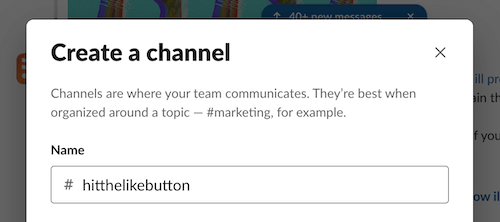
Larry points out that this strategy was widely employed on Facebook 15 years ago; however, Facebook quickly figured out ways to filter out this kind of thing and it doesn’t work anymore. LinkedIn is a time machine. Their algorithm is more like Facebook’s algorithm 15 years ago. The algorithm will give you the benefit of the doubt. It will audition that content that you’ve just surfaced, and that content will accrue more impressions.
Just getting your friends and family to engage with your content can give you your first 5,000–10,000 impressions. The friends and family liking your content is just a catalyst to get the initial few thousand impressions for free. Whether you get to 100,000 impressions is more of a meritocracy. Does it die out very quickly or is it one of these more viral posts that everyone sees and engages with and it just explodes?
This isn’t illegal. You’re just noticing how the thing works and you’re trying to send as much signal as possible to that news feed algorithm to generate an outcome that’s beneficial to either your personal brand or to your business.
One thing you can do is audition content elsewhere. If you look at Larry’s LinkedIn feeds, you’ll see mini-infographics about unicorns and other things. These ideas are curated elsewhere, mainly on Twitter.
Larry knows that his average tweet gets about 25,000 views and maybe 30 retweets, but 10% of them get 100–1,000 retweets. Posts that do well on Twitter get reposted to LinkedIn. If something was really funny or thought-provoking or engaging, to the point where people wanted to comment on it and reshare it on Twitter, there’s a high chance people would also like to engage with it on LinkedIn.
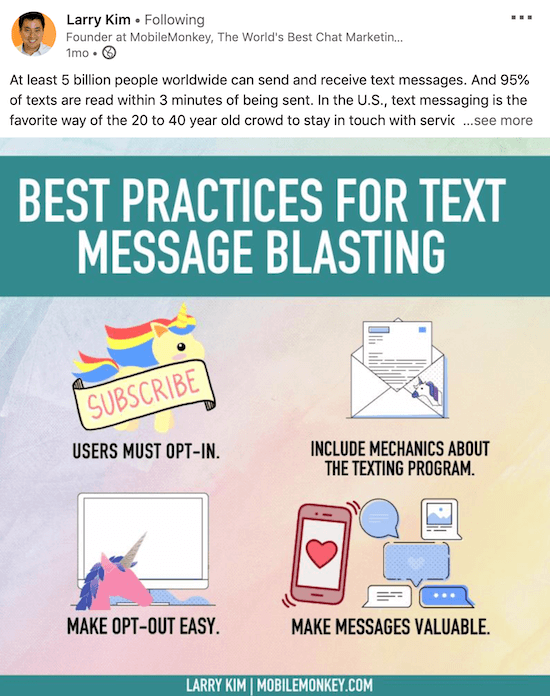
If you’re doing LinkedIn Pulse blog posts, you can push traffic to that page on Facebook. One great way to get lots of discussion is to specifically promote it to people who have the opposing view.
If your article is about the Keto diet, target a bunch of people who like the Paleo diet on Facebook. Then show that ad to the people on Facebook through your LinkedIn page. They’re going to be mad. They’re thinking, “This diet sucks. You have to do Paleo instead, not the Keto diet.”
If you’re just promoting the content to people who are already in love with the idea, there’s nowhere to go with the discussion. If you promote it to people who hate it, they’re more likely to comment. The LinkedIn algorithm requires comments and comment replies, and it weighs longer-form comment replies as being more valuable. You just have to break it down and run some experiments.
LinkedIn Company Pages vs. Profiles
I ask Larry whether organic content performs better on personal profiles or company pages.
Larry notes that there’s a dampening factor that’s applied to company pages. Naturally, LinkedIn wants to force companies to pay money for ads to get the company page’s messages out. It’s still possible for company content to get a lot of traction, but the extent of the magnification of those user interactions is diminished.
Ten likes of a post on your personal profile would give you 10,000 views. Those same people liking and commenting on a company post are going to generate maybe a fifth as many views.
It’s still nothing to sneeze at. But when you look at the posts in your LinkedIn feed that have a lot of likes and comments, they tend to be from individuals, not businesses.
Riding the “Trending” Wave on LinkedIn
It’s really challenging to notice something that’s trending and jump on it quickly. But if you have that capability, there’s nothing more powerful in social media than a far-reaching topic that has legs beyond your niche.
If you’re clever and nimble enough to recognize those trends, then that’s a very powerful force to ride. It is winner take all. Typically, the few people who get to it first tend to generate the lion’s share of that engagement because of how these things snowball, and it rewards the thing that has the most engagement. But it’s definitely a part of the strategy.
It’s harder to turn that into a formulaic approach because you never know when those things are going to fly by. News is always happening but who knows when news of that magnitude is going to come out?
Larry prefers to work in a way that is a little more formulaic. You can audition content and come up with the top 10 posts over the last year, and then you can migrate those from Twitter to LinkedIn. It’s a repeatable recipe that doesn’t require some external thing happening, and if it has wings over here, it might have wings over there.
Auditioning Organic Content on Twitter for Inspiration
I mention to Larry that it sounds as if he’s doing something different on Twitter to have stuff to be auditioned potentially on the other platforms. Where do his ideas come from for the auditions, and is Twitter the place where he auditions everything?
Larry tells me that LinkedIn’s algorithm, as well as Facebook’s, has a dampening factor in the feed algorithms: If you post too frequently, your next post will take away from the previous post. There are people who post on LinkedIn once every minute, and those things go nowhere.
Becoming Well-Known (May 4 – June 12, Online Event)

What could you achieve if more people heard your message? Imagine building a name for yourself and becoming more well-known. It’s times like this that present an opportunity for you to make a bigger impact on the world. If you want to be more known but don’t know how, check out the new course from SME founder Michael Stelzner: Becoming Well-Known. He’s mentored and advised dozens of industry pros, including Amy Porterfield, Mari Smith, and Pat Flynn. Let Mike guide you through his proven process to Becoming Well-Known.
There’s no punishment for posting a lot on Twitter. Tweeting twice in a row doesn’t make the first tweet any less likely to be seen. That makes Twitter a really great place to audition content because you don’t have to worry about spreading those posts out.
You can just try things and you don’t have to keep them on your wall. If you posted 2 or 3 hours ago and you’re not seeing a certain amount of engagement within the first hour or so, then by all means, delete it and try something else.
Larry can come up with lots of posts because he has a filter. There are only a few key topics he really cares about: social media, entrepreneurship, startups, and technology stuff.
He has those high-level topic filters and uses a combination of third-party tools and some internal programs he’s developed on his own to screen the news for what’s trending and what’s generating engagement. Using those tools and programs, Larry can spend just a few minutes every day or two picking some ideas up from Twitter that might work elsewhere—like on LinkedIn.
If it’s just a topic that’s fairly general and doing well, and it’s not attributed to anyone—such as a study of the most important skills to have on LinkedIn in 2020—Larry might riff off of that idea to create his own content.
For example, he would come up with an infographic called, “The Top 10 Characteristics of a Unicorn Marketer in 2020.” He might curate some of the skills and criteria from that report but then put his own spin on it. To visualize this, he’d pick 3 out of 20 points from the study that he agrees with and then add 7 of his own that he feels are really important. Then he’d publish the content on LinkedIn.
If you scroll through Larry’s LinkedIn, you’re going to see lots of these mini-infographics. They’ve all been auditioned on Twitter and that’s why they then appear on LinkedIn.
Organic Content in Facebook Groups
Unless you’re publishing a large volume of content, Facebook groups are really the only game to play on the platform.
Larry’s MobileMonkey group has around 35,000 members and is getting 30% engagement rates. On average, 20%–30% of the people in that group will see any post that he puts in there. It’s all about the engagement and the responses. You see the content from the groups that you’ve engaged with and you don’t see the content from the groups you haven’t engaged with. There’s a group engagement hygiene.
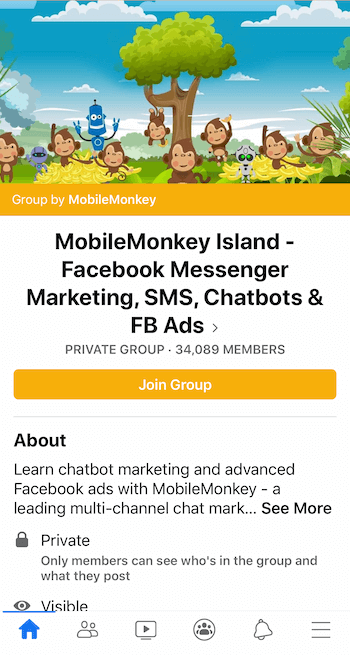
You’ve got to be clever about it. It’s not just about posting things to the group and hoping everyone will see it and engage with it. You have to understand how those algorithms work and you have to do the kinds of things that will result in your posts being surfaced.
Larry recommends that every Monday you do an icebreaker like, “Where are you from?” Post that on your group and you’ll get 400 responses. People like to talk about themselves. But that little thing that you just did there will juice the engagement for your group for the next week.
If you’re hoping to use Facebook groups as a page traffic driver, that’s not the way—or rather it would be a very algorithmically challenging way. It used to be that every time you did a blog post, you would post a link to it on your Facebook page. That strategy is dead.
But there might be three main points of the blog post or a mini graphic you could post to your group and include a link in the first comment. Then have your cabal engage with that post a little to give it some love. That way, it gets auditioned among that group.
That’s a little more work but the whole point is to drive engagement. If you’re not doing that extra work, then why are you bothering to post in the first place? If you do that extra work, it actually becomes a valuable exercise as opposed to a waste of time.
Organic Video Content
Larry has gotten a lot of leverage out of video. He’ll record a webinar and then simulate a live stream to all of his other social channels. That’s a lot of social channels because there’s Larry’s own social channels plus MobileMonkey’s channels. He’ll live-stream the same video to 12 different social channels and it’s still algorithmically favorable to do this; not as much as it used to be but it’s still better than just posting static content.
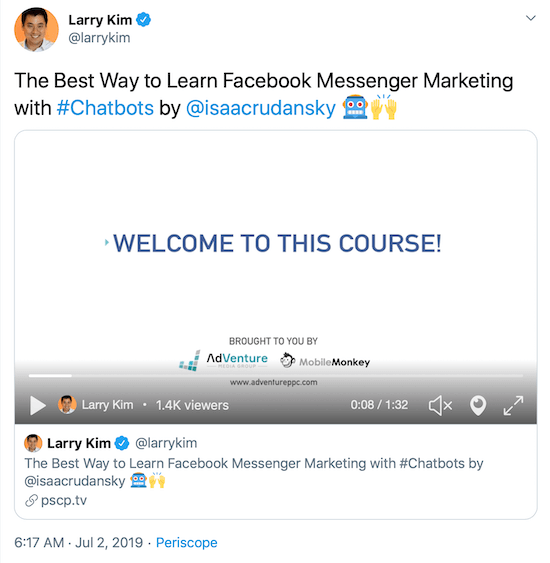
Think of it as a television station that runs in syndication. Larry has a library of video content that’s still relevant. Certainly, you wouldn’t rebroadcast news stories from 2 years ago but there’s going to be some content that’s evergreen.
Larry has a rotation schedule where he does two live streams per channel and just rotates through the library. Nobody notices because nobody catches every single live stream that he does and there’s enough content that the chances of them seeing something twice are extremely low.
Larry suggests that you come up with a library and then stream that into two different channels in different orders so it’s truly randomized. This requires a little bit of organization but it can be outsourced to a virtual assistant. Once you understand how to live stream, it’s just mechanical work that’s not very expensive to do.
Organic Content on Medium
Larry was in an Uber the other day and the driver asked him if he was Larry Kim. It turns out that the driver follows Larry’s content on Medium.
Larry gets somewhere between one to three million views on his content on Medium every month. It’s been incredibly valuable for his personal branding. He’s been doing it for 6 years now and he’s the ninth most popular blogger on that platform. Some of the people who are ahead of him include Ev Williams and Gary Vaynerchuk.
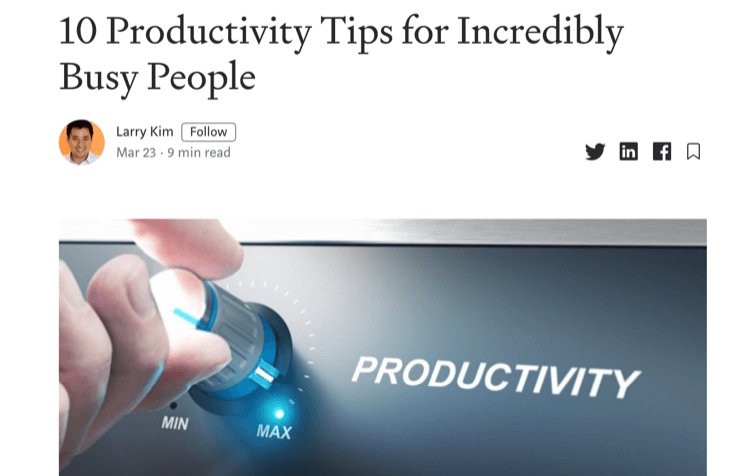
The Medium audience is primarily tech people. It’s the same people who’ll read Wired magazine or TechCrunch. They have a lot of interest in topics like entrepreneurship, tech, and how to start a business. That higher-level stuff is really useful for Larry’s company, too, because MobileMonkey customers tend to also be entrepreneurs and startup people so the demographics are similar.
Medium is a way to cast a much larger net on much broader topics than Larry would normally write about. Today on this podcast, we’re in the weeds of news feed algorithms. That wouldn’t be an appropriate topic for Medium. Sometimes to grow your business, you have to cast a larger net and talk about topics outside of your usual niches.
Larry’s Uber driver went on to tell him he’d read his article about how to start a business, and that he wanted to start his own business someday. Larry believes he’s going to do it. The hope is that he’ll remember Larry, and then when it comes to requiring marketing or messaging software, he’ll remember MobileMonkey. Writing for Medium doesn’t have a super-high conversion rate but it’s about casting such a broad net that it’s still a meaningful net positive to your brand or business.
The first thing to know about Medium is that it doesn’t have a duplicate content penalty. Unlike LinkedIn, where it throttles you if you post a lot, people post so infrequently on Medium that there is no duplicate content there—meaning that you should syndicate your content.
If you just have three articles that are evergreen, you should repost them every week or every month because there’s no downside. There are no duplicate penalty costs. You wouldn’t know that Larry syndicates content and puts it on reruns because his content library is so large. It’s thousands of articles, but if you look closely enough, you’ll see some repetition.
The second thing is you need a publication. People can follow individuals and they can also follow publications. Larry has a publication called Marketing and Entrepreneurship. It’s the largest publication on Medium with about 40,000 subscribers.
When Larry posts, there’s a good chance that the 200,000 people who follow him on Medium plus the 40,000 people who subscribe to the publication will see his content because the content is subscribed to that publication.
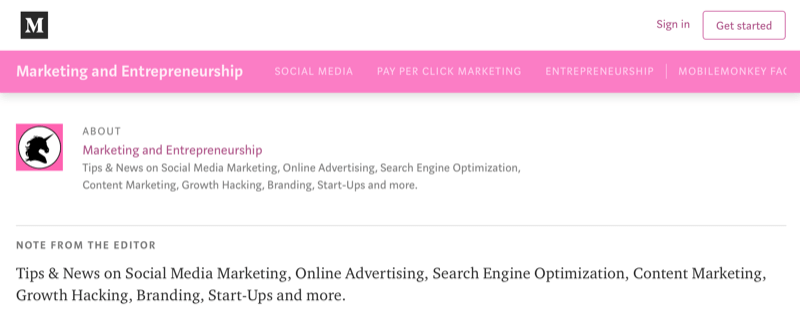
Another tip is to drive traffic to those articles. Medium’s system is based on claps. If your article gets surfaced in those daily digests that get sent out or in the app or on the website, that means you have to throw a lot of traffic toward it.
There’s a guy Larry follows on Medium who has a big email list and he uses Medium to collect those emails. Every time he posts something new to Medium, he sends an email directing his email list to that post so that it generates claps. It’s a nice little flywheel he’s developed there.
There are plenty of big announcements and news breaks on Medium. It’s basically Twitter in long form. It’s an interesting channel that’s chronically underused by marketers.
The goal is not to do everything but to do a few things well. Those are the platforms or channels that Larry is focusing on, and he’s doing really well on them—organically.
Key Takeaways From This Episode:
- Find out more about Larry on his website.
- Read Larry’s MobileMonkey blog.
- Follow Larry on Twitter, LinkedIn, and Facebook.
- Find Larry on Medium and subscribe to Marketing and Entrepreneurship.
- Email Larry via [email protected].
- Learn more about Becoming Well-Known at becomingwellknown.com.
- Watch exclusive content and original videos from Social Media Examiner on YouTube.
- Watch our weekly Social Media Marketing Talk Show on Fridays at 10 AM Pacific on YouTube.
What do you think? What are your thoughts on the power of organic content marketing? Please share your comments below.
